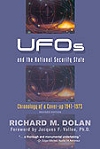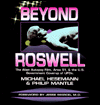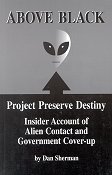
The Science of UFOs (William R. Alschuler, St. Martin’s Press, $23.95). What if UFOs are real? Where could they be coming from and how could they have traveled here? What advanced technologies must they possess to execute the fantastic maneuvers they are routinely reported to make? These are the key questions that scholarly title asks. Alschuler takes us on a fascinating journey covering everything from faster-than-light travel to teleportation and inter-dimensional travel. He also addresses the possible motives of visiting alien species and alien bio-chemistry. A first-class, technical-minded look at the UFO mystery and its relationship to the world of science.
UFOs, JFK and Elvis: Conspiracies You Don’t Have to be Crazy to Believe (Richard Belzer, Ballantine Books, 2nd printing, 230 pages, hardcover, $24). This Belzer’s first book and executes an outstanding review of the facts in a very credible manner, citing additional experts and weaving humor into a very serious subject. The reader will come away with a new appreciation for the complexity and obvious failings of the JFK investigation and a real feeling that the assassination was not done by one lone nut. The UFO section, like the complete book is highly readable, with a steady stream of “factoid” inserts mixed with highly shocking yet credible references.
Why the Press Acts that Way (Don Berliner, International UFO Reporter, Sept/Oct 1992). This short article deals with several significant points about how UFO-related news is treated by the media and why. A frequent subconscious assumption made by the uninformed is “If all this is true, I surely would see it somewhere else than in the tabloids.” The active or passive control of media reports is a definite part of the puzzle, rarely treated explicitly.

The Day After Roswell (Col. Philip Corso, Ret., William Birnes, Pocket Books, 1997, 342 pages, hardcover, $24). Corso’s book already is a landmark in ufology in as much as he was the first to come out and say “I was there, saw a body and used my military position to help American companies reverse engineer exotic alien technologies.” The book lacks references, a table of contents, and an index. The co-author, Birnes, confuses UFO Roswell events by not telling the reader when Corso is being quoted or when Birnes is speculating.

UFOs and the National Security State (Richard Dolan, Hampton Roads, 478 pages). UFOs and the National Security State is the first volume of a two-part detailed chronological narrative of the national security dimensions of the UFO phenomenon from 1941 to the present. Working from hundreds of declassified records and other primary and secondary sources, Richard Dolan centers his investigation on the American military and intelligence communities, demonstrating that they take UFOs seriously indeed. Included in the first volume are the reports of more than fifty miiltary bases relating to innumerable violations of sensitive air space by unknown craft, and analyses of the Roswell controversy, the CIA-sponsored Robertson Panel, the Condon Committee report, and much more. Dolan’s book has been described by Apollo 14 astronaut Edgar Mitchell as “thorough and monumental, and by Dr. Harold E. Puthoff of the Institute for Advanced Studies at Austin as “a must-read for serious students of the field.”

The UFO Cover-Up (L. Fawcett & B.J. Greenwood, 1984). This significant compilation of “Freedom of Information Act” (FOIA) data makes it extremely clear that the U.S. government has been aggressively concealing its interest in UFOs. Military intelligence is NOT an oxymoron, but you are encouraged to believe that it is. This book displays an unambiguous pattern of government interest, coupled with numerous examples of duplicity (saying one thing and doing another). It should convince you that the government has successfully been keeping some secrets, contrary to popular opinion.

TOP SECRET / MAJIC (Stanton T. Friedman, Marlowe, 1996, 272 pages, 5th printing, hardcover, $23). is the most authoritative book about the Eisenhower Briefing Document (EBD), describing a top secret research, development and intelligence operation. It is built on close to fifteen years of research with archives, historians and authentication experts looking at the real chance that the government and our Presidents have been informed, involved and covering-up since 1947.

Beyond Roswell: The Alien Autopsy Film, Area 51, & the US Government Coverup of UFOs (Michael Hesemann & Philip Mantle, Marlowe, 1997, 1st printing, 303 pages, hardcover, $25). The authors and publisher put together a well produced book, with lots of rare photographs and a solid 65-page multi-chapter discussion of previously-published UFO documents. Problems include very limited discussions of validation issues, lowering the credibility of the book.

Beyond Top Secret: The Worldwide UFO Security Threat (Timothy Good, Sidgwick & Jackson, UK, 1996, 6th printing, 606 pages, hardcover, £17, $35 in U.S. stores). An expansion of Timothy Good’s best-seller British book Above Top Secret, the book provides a compendium of high-quality, world-wide reports, interviews and related documents. It has strong chapters about DIA and CIA involvement, good references, and unlike most books has a superb index. It lacks any detailed effort to evaluate a variety of documents; in fact, it has moved away from the controversial Eisenhower Briefing Document by eliminating any discussion of it, even though Good was the first to publish the EBD in Above Top Secret in 1987.

Alien Base (Timothy Good, Century, 1998, 419 pages, hardback, £16.99). The prime focus of Good’s book is that of direct interaction between human beings and alien visitors. Alien Base largely steers clear of so-called alien abductions, abductees, and experiencers, however, and instead focuses for the most part on the contactee aspect of the UFO mystery. Whilst such accounts are certainly not fashionable and in many circles are viewed with either suspicion or outright derision, Good carefully (and to his credit) analyzes the evidence (and lack thereof in a number of cases) of a host of individuals who have claimed contact with human-like aliens — including George Adamski, Daniel Fry, and Howard Menger — and whose accounts are steeped in controversy. The book also contains important material on the late Lt. Colonel Philip Corso, his book The Day After Roswell, and the New Mexico UFO crashes of 1947.

Disclosure (Steven M. Greer, Crossing Point, Inc Publications, 2001, 573 pages, soft-back). This is essentially a collection of varied testimony from numerous military and government individuals divulging their knowledge of UFO encounters, landings, crashes, cover-ups, official investigations, and more. For those interested in Roswell and Majestic 12, the book contains much that will fascinate, including in-depth testimony from Philip Corso, Glenn Dennis, and Walter Haut. Equally fascinating are the accounts of Larry Warren concerning the Rendlesham Forest case of December 1980; the British Ministry of Defense UFO investigations undertaken by Nick Pope; and a host of pilot encounters, radar-visual events, and more.

Unconventional Flying Objects: A Scientific Analysis (Paul Hill, Hampton Roads, 1995, 430 pages, paperback, $15). With a foreword by Dr. Robert M. Wood, Hill’s book is widely acclaimed as the most scientific and detailed technical analysis of flying saucer design and operation. Compiled over a 30-year career as a NASA engineer, the late Hill did a masterful job at ferreting out science and technology behind the elusive UFO performance characteristics, demonstrating they likely are exotic advances of our current science and technology.
The UFO Experience: A Scientific Inquiry (J. Allen Hynek, 1972). This landmark book defined the personalization of the reports, showed that the more reliable reports were more “strange,” and defined the “close encounter” scales. Hynek was key in defining the parameters of the problem.
The UFO Controversy in America (David Jacobs, Indiana University Press, 1975). This book, completed as a Ph.D. thesis in 1975, provides a superior historical balance in describing the issues and attitudes, which still apply today. This is the view of the historian, objectively summarizing the applicable references.
UFO – An Appraisal of the Problem (J.P. Kuettner, et al. Astronautics and Aeronautics, 8, No. 11, 49). See also: McDonald, J.E. (1971). “UFO Encounter I.” Astronautics and Aeronautics, 9, No. 7, 66 and Thayer, G.D. (1971). “UFO Encounter II.” Astronautics and Aeronautics, 9, No. 9, 60. These three papers are noteworthy because they reflect the results of an official subcommittee of a professional society. They deal with two very specific, thoroughly reported cases, they are short pieces, easy to digest, and one was written by James E. McDonald, a tireless fighter against UFO “cover-up” or “foul-up.”

Abduction (John Mack, Scribner). John Mack, a Pulitzer Prize Winner and a Professor of Psychiatry at Harvard Medical School’s Cambridge Hospital, digs deep into the world of UFOs and alien abductions and produces a thought-provoking and essential read for anyone with even a remote interest in these topics. At the time of writing the book in 1994, Mack had interviewed seventy-six people that had reported the abduction experience; and in Abduction he presents the testimony of a number of those interviewees. Running throughout the book are two central themes: that the purposes of alien abductions are (a) to change human consciousness to prevent the destruction of the eco-system; and (b) to create offspring from human-alien hybridization. A cornerstone publication on this emotive topic.

Alien Agenda (Jim Marrs, Harper Collins, 1997, 1st printing, 435 pages, hardcover, $24). Alien Agenda is an excellent overview, status report and digestion of alien related data. Its strength is its breadth: ancient astronauts, crop circles, cattle mutilations, government involvement, documents, abductions, remote viewing, sightings, investigations. It screens and reports some of the highest-quality events.

Rule By Secrecy (Jim Marrs, Harper Collins, 2000, 467 pages, hardback, $27). From the author of Alien Agenda and Crossfire comes a new title that delves into the murky world of hidden and powerful groups with equally hidden and powerful agendas. Stretching from ancient times to the present day, Marrs describes in painstaking detail the power wielded by those who really control the world and how wars have begun and ended in their name — and also at their command. Have you ever wondered who really controls the stock-market or who censors our news? Jim Marrs provides the answers and in doing so reveals the truth that lies behind the workings of the Trilateral Commission, the Bilderbergers, the CIA, the Illuminati, the Freemasons, and even the Vatican. A must-read for anyone even remotely interested in secret societies.

Secrecy (Daniel P. Moynihan, Yale, 1998, 262 pages, hardback). The Chairman of the Commission on Protecting and Reducing Government Secrecy, Senato Daniel Patrick Moynihan has written a fascinating account of the development of secrecy as a mode of regulation in the U.S. Government since World War I through to the present day. Along the way he tells the story of the Venona Project (the Soviet spy cables intercepted during World War II and decrypted by the U.S. Army but never passed on to President Truman); the era of McCarthyism; the Bay of Pigs affair; Watergate; Iran-Contra; the fall of the Soviet Union, and more. Moynihan argues that many of the tragedies that resulted from these events could have been clarified in an open exchange of ideas. America, says the author, must lead the way to an era of openness.

Cosmic Crashes (Nicholas Redfern, Simon & Schuuster, £16.99). In his latest book, Nick Redfern focuses his attention on what could arguably be called British Roswell’s: accounts pertaining to crashed UFO incidents in Britain. Contained in the book is information on: (a) the crash of a Foo Fighter and the recovery of alien bodies in the UK during the Second World War; (b) the crash-landing of a UFO at a military base in England in the early 1960s and a formerly-classified file on the case; (c) the crash of a small, triangular-shaped UFO in the mid 1960s, its retrieval from a forest by military personnel and the interrogation of civilian witnesses to the incident; (d) the crash and recovery of a UFO and alien bodies from a mountain in Wales in January 1974; (e) secret locations where UFO debris and alien bodies are believed to have been taken; (f) official and unofficial files on crash-retrievals and more.

The F.B.I. Files: The FBI’s UFO Top Secrets Exposed (Nicholas Redfern, Simon & Schuster, 1998, 1st printing, 354 pages, hardcover, £17). This is Redfern’s second book and he does a masterful job weaving a story with FOIA released FBI documents and other sources. He has chapters about the Eisenhower Briefing Document and Majestic, both important to our pending book. The book is very similar to ours, except that ours has dramatically more arresting evidence of military and covert action, and emphasizes the authentication work. The F.B.I. Files was released in the U.S. in November 1999.

A Covert Agenda (Nicholas Redfern, Simon & Schuuster, £16.99). This was Nick Redfern’s first book on UFOs and it deals with his investigation of the British Government’s UFO studies undertaken from the late 1940s to the present day. Redfern primarily uses official Royal Air Force and Ministry of Defense documents made available via the government’s Thirty Year Ruling to demonstrate the way in which the UFO subject has been monitored at an official level. In the book he reveals how huge UFOs have been tracked on radar in Britain’s airspace; close encounters between UFOs and military pilots; warnings made to Britain’s military not to talk about UFOs outside of official channels; the secret UFO investigations undertaken at a strategic military base – RAF Rudloe Manor; the Rendlesham Forest incident of December 1980; and covert monitoring of UFO activity by the RAF’s Provost and Security Services. The book also contain a chapter on crashed UFO incidents in the UK.

The Wizards of Langley (Jeffrey T. Richelson, Westview, 2001, 386 pages, hardback). In 1956 the CIA dramatically breached the Iron Curtain when its U-2 began overflying Soviet territory to photograph that nation’s military installations. Four years later, the Soviets shot down pilot Francis Gary Powers and his U-2, thereby ceasing these missions. Within months, however, the CIA had another, and better, technical program in operation – the Corona satellite. Throughout the Cold War and beyond, the CIA’s scientific wizards continued to devise high-tech ways to collect and analyze information about potential adversaries. Their mission was of such importance that a new branch of the CIA was created – the Directorate of Science and Technology. In this first full-length study of the CIA’s D of S&T;, Richelson introduces the reader to key individuals who helped shape the directorate: Edwin Land of Polaroid, and Albert Wheelon, Carl Duckett, and Albert Mendez, whose skills helped nine Americans escape Iran after the seizure of the U.S. Embassy in 1979.
The Report on Unidentified Flying Objects (E. J. Ruppelt, Doubleday, 1956). This is an early classic, based on an official Air Force alleged search for data in the early 50s, told by the officer in charge at the time. A very personalized account with refreshing detail, high realism, and much believability. It does not, however, deal with the question of who received the high-level hard data.

Above Black (Dan Sherman, Morris Publishing, 1998, 147 pages, soft-back, $18). A modestly-sized little book, this tells the fascinating story of Dan Sherman (USAF, retired) and his dealings with something known as Project Preserve Destiny — a UFO/alien related black project with links to the National Security Agency, CIA, National Reconnaissance Office, and the U.S. Air Force. According to the book, Preserve Destiny was tasked with training select individuals to communicate with alien creatures on a one-to-one basis. The book is certainly controversial; however, Sherman’s credentials as 12-year USAF veteran (who was awarded the AF Commendation Medal, the AF Outstanding Unit Award, and was honored for his service in the Persian Gulf War) make this a book that should be digested carefully and thoughtfully.

Confirmation: The Hard Evidence of Aliens Among Us (Whitley Strieber, 1998, 256 pages, hardcover, $24). is focused on the abduction experience and the medical and physical evidence that has surfaced. Alien implants confirmed by X-Rays, MRI’s, and doctors, in hands, feet, ears, eyes, and nasal cavities along with victim testimony continue to show that the phenomena is real, physical, and with a disturbing mission. Confirmation complements our planned book by focusing on the medical and physical evidence while we focus on governmental documentary evidence.

A Guide to UFO Research (Michael Swords, 1993. Journal of Scientific Exploration Vol. 7, No. 1). The task we are attempting to do was exhaustively dealt with in this comprehensive article in JSE. Swords’ extensive familiarity with the entire range of literature would make him ideal to give the answer to “Where do I find … ?” questions. It is valuable for a novice to read this one first to obtain a grasp of the enormous scope of the subject before diving too deeply.

Blank Check: The Pentagon’s Black Budget (Tim Weiner, Warner Books, 1990, 274 pages, 4th printing, hardcover, $22). Weiner, a Pulitzer prize-winning reporter, does a superlative job of discussing military secrecy, laws, lies, and the violations of the Constitution. Even though Blank Check does not discuss UFOs, it is relevant for clear proof that funding can and does exist for covert operations on the multi-billion dollar scale required to support an ongoing UFO, alien technology, and intelligence project. Its major weakness is the Department of Defense-only focus.
